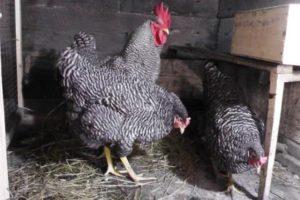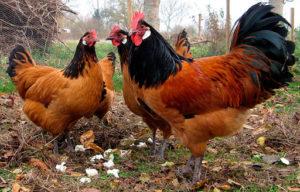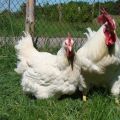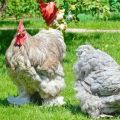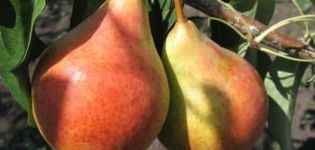Characteristics and description of chickens of the Brahma breed, egg production and maintenance
Chickens of the Brahma breed are very popular with farmers. This is due to its excellent performance and attractive appearance. India is considered the birthplace of this breed. It was from there that the birds came to America and Europe. Today there are many varieties of this breed. They differ in color, direction and other parameters. Also, on the basis of the breed, dwarf chickens were bred, which differ from large relatives only in size.
Content
- 1 History of origin
- 2 Description and characteristics of the breed
- 3 Appearance and varieties of chickens Brahma
- 4 The nature of the birds
- 5 Weight of layers and roosters
- 6 Productive qualities
- 7 Main advantages and disadvantages
- 8 Features of maintenance and care
- 9 Feeding rules
- 10 Breeding chickens
- 11 Common diseases and their prevention
History of origin
The data on the origin are very contradictory. It is believed that the Brama chickens were bred from the Cochin and Malay birds. Southeast Asia is considered the homeland of birds. For several hundred years, Indo-Chinese monks raised decorative chickens and kept them at temples.
In the middle of the nineteenth century, birds came to America. The breed was registered in the United States in 1874. American scientists have worked hard to improve meat characteristics. That is why in the country this type of chicken is still considered exclusively meat. This includes, in particular, the light or Columbian breed.
At the same time, chickens became widespread in Europe due to their decorative characteristics. Beautiful birds were bred primarily to decorate the yard. Therefore, European breeders made efforts to improve the decorative properties of birds, while the meat qualities were ignored. In Asia, they are considered decorative meat.
Description and characteristics of the breed
Brahma chickens are characterized by the following features:
- The color is different. There are gray, black, brown birds. There are also partridge and silvery-white tones.
- There are colored types of chickens. They are red and yellow. There are beautiful blue and white birds.
- Birds have quite a lot of ashy down. Feathers are soft and fit well to the body. Males have a collar of a contrasting shade.
- The skin is yellow.
- The birds are characterized by a small head with a wide forehead. The ridge is three-row and has no distinct teeth.
- The constitution is quite dense. The birds are characterized by a wide chest, back, abdomen. The body has a high fit.
- The wings are well developed. Chickens also have strong and long legs. They are completely covered in feathers.
- The neck is medium in length.The top is covered with a voluminous mane and has a slight curve.
- The beak is strong and has a yellow tint.
- The birds have rich orange eyes and high brow ridges.
- The lobes and earrings are red. They differ in average length. There is a fold under the beak.
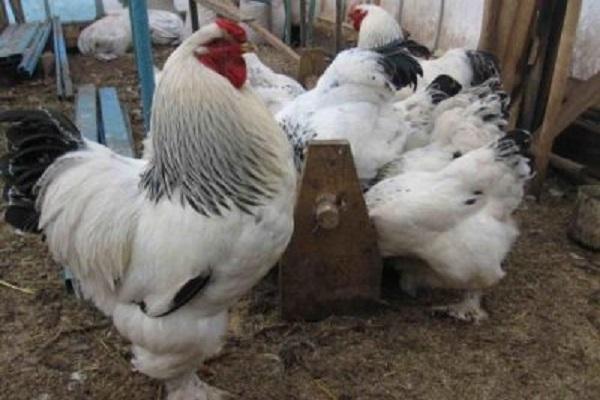
White tail and yellow feathers are unacceptable for these birds. Also, they cannot have black stripes in the belt area against the background of the predominance of light feathers.
Appearance and varieties of chickens Brahma
There are many types of chickens of this breed. They differ in certain features.
Light
Such birds are characterized by impressive size. They have powerful legs and broad chest. The birds are distinguished by a rich red comb and earrings. Light-colored chickens have silvery white feathers. The mane and tail are black with a slight greenish tinge.
Initially, it was a meat variety that can live in fairly strict conditions. The weight of adult males was 7 kilograms. Since the eighties of the 20th century, decorative properties have come to the fore. Today, the weight of roosters does not exceed 5.5 kilograms, chickens - 4.5 kilograms.
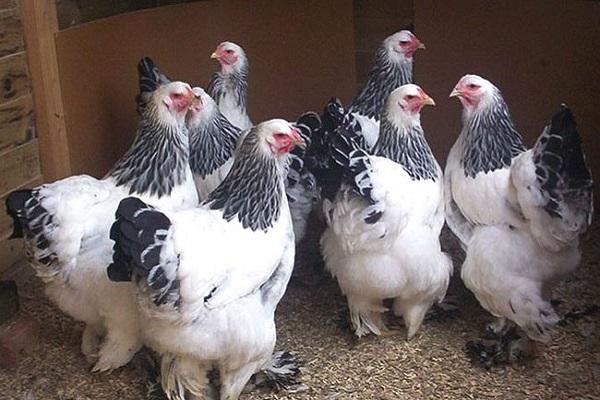
Chickens begin to lay eggs at 8 months. They are large in size, strong shell, dark ocher hue. By the third year, productivity falls. A 5-year-old hen brings no more than 50-60 eggs.
Dark
This species is characterized by differences in the color of females and males. Layers are gray or blue-gray and have a black mane. Contrasting with black stripes on the chest and sides. Roosters are characterized by a silvery white hue. There is a black stripe on the wings.
On the exterior, this variety of chickens is close to the Cochinchins. In terms of performance, weight and character, the dark variety is more reminiscent of the light breed.
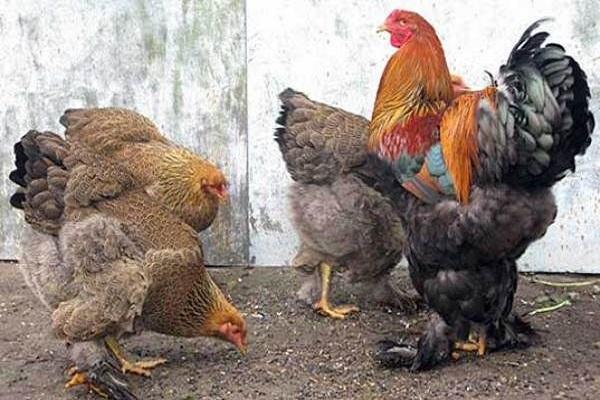
Fawn
In terms of appearance and size, the chicken resembles the previous varieties. It is characterized by a brown tint with a golden tint. Females have a dark mane and tail. On the head, back, sides and mane of males there are feathers of a rich red hue. They are covered with dark stripes. Roosters have a black tail.
An excess of red or yellow shades is considered a disadvantage of coloring. In terms of size and performance, this species of birds resembles a light one.
Partridge
The shade of chickens resembles partridge feathers. This can be seen in the outlines of the feathers on a pale yellow background. The eggs of this breed have dark specks. Males have a rich reddish tint. It is present on the back, sides, chest, neck. The rest of the feathers are black.
In terms of weight, chickens are somewhat inferior to the light variety. The mass of roosters is no more than 4.5 kilograms, chickens - 4 kilograms. Every year, a hen produces 110 eggs weighing 55 grams.
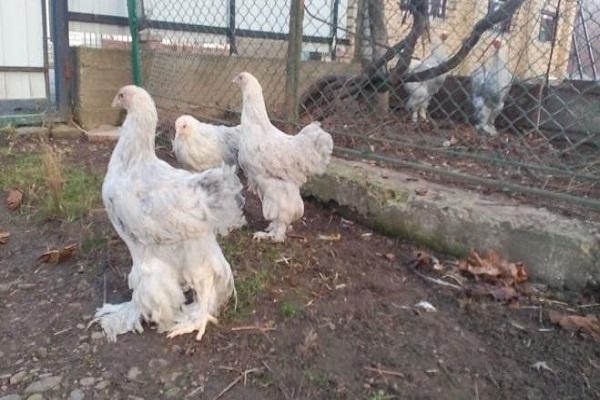
Isabel
This is a dwarf breed of chickens. They are distinguished by a gray-blue color. The head, neck, part of the back have a white-yellow tint. Chickens are characterized by fluffy and clean feathers. Feathers and down cover the feet and toes. The birds have a proud bearing.
The weight of the roosters is 2.5 kilograms, the hens are 1.5 kilograms. This variety is characterized by low productivity - up to 80-100 eggs per year. Each egg weighs no more than 35-40 grams.
The nature of the birds
This breed is hardy and unpretentious. Birds are considered resilient. They do not require a large chicken coop or an impressive walking area. Birds have an excellent character - they are considered calm and even somewhat phlegmatic.
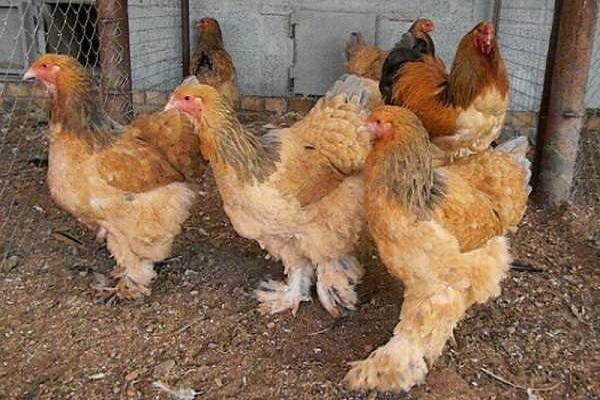
Weight of layers and roosters
The average weight of laying hens is 3.5-4 kilograms, the mass of roosters reaches 4.5-5 kilograms. During the heyday of the breed, birds weighing more than 7 kilograms came across. However, today such giant chickens are practically not found.
Productive qualities
For chickens under 2 years old, high egg production rates are characteristic. They produce 120-150 eggs per year.Then performance drops noticeably. Chickens begin to lay eggs at 7.5-9 months. Their weight is 55-60 grams.
The weight of the dark chicken Brahma does not exceed 4 kilograms. The light variety weighs slightly less - 3-3.5 kilograms. The weight of the roosters is 4-6 kilograms. The preservation parameters of young stock are 70%. For adult birds, this figure rises to 90%.
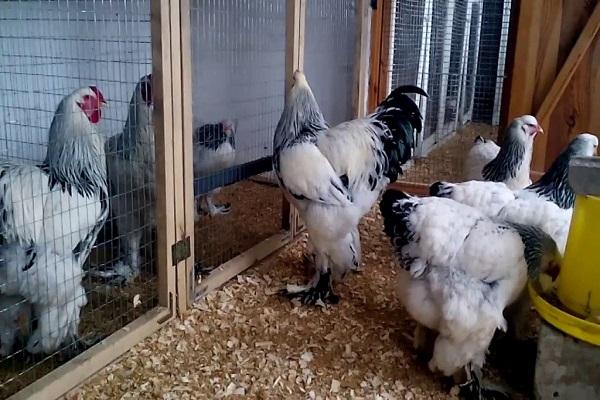
Main advantages and disadvantages
The key advantages of chickens of this breed are the following:
- high meat productivity;
- excellent vitality;
- unpretentiousness to the climate and the size of the chicken coop;
- good decorative characteristics.
At the same time, chickens also have certain disadvantages. These include the following:
- high cost of feed and other materials;
- a long period before the start of egg production;
- small physical activity of birds.
Features of maintenance and care
To increase the productivity of birds, strengthen their immunity and avoid the development of diseases, it is worth providing them with quality care.
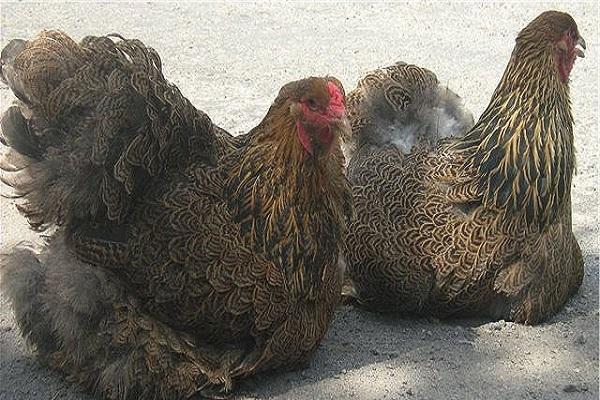
Chicken coop requirements
Meat breeds are bred using 2 methods of keeping - floor or cage. For Brahma chickens, the first option is preferable. It involves the use of deep bedding and daily walks.
A maximum of 5 chickens should be placed on 1 square meter. It is definitely recommended to pay attention to the perch. The die width must be at least 30 centimeters. The perch is removed from the floor surface by 40-50 centimeters.
The recreation area should be organized at a distance, with a slight bias. Baskets, wooden boxes or buckets are used to arrange nests. At the bottom it is worth laying hay or straw. 1 nest is enough for 5 chickens.
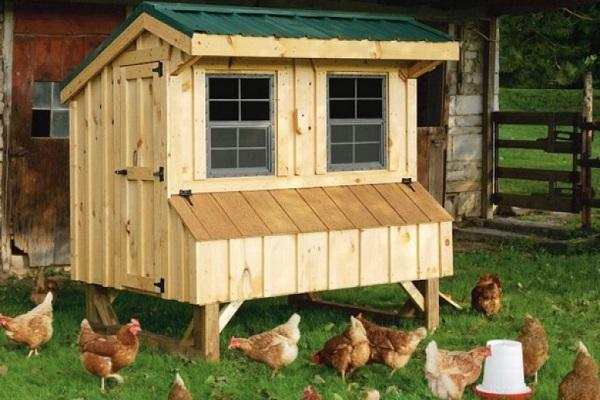
Place for walking
In size, the walking area should be three times the area of the chicken coop. When designing this area, it is recommended to take into account that the ground should be covered with grass.
Drinkers, feeders and ash baths
Drinking bowls with fresh water should be present in the house. It is also worth using separate containers for grain and wet mash.
Ash baths are of no small importance. They are required to cleanse feathers and skin and to remove parasites. To do this, take boxes 15-20 centimeters high and fill them with dry sand and wood ash.
Seasonal molt
Chickens are characterized by seasonal molting, which somewhat spoils the decorative properties of birds. To speed up the recovery of feathers, fish oil and vitamin products should be introduced into the diet of birds. At this stage, a decrease in egg production is observed.
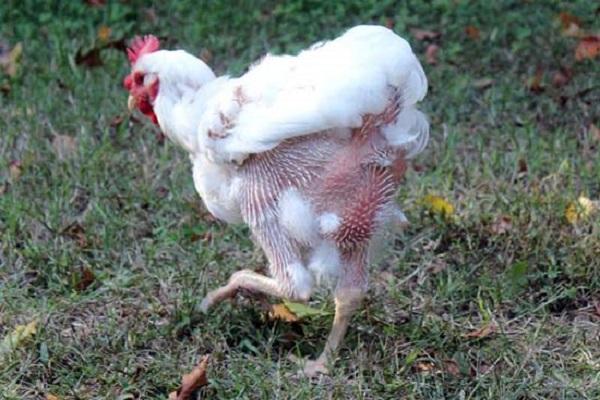
Planned replacement of livestock
To replace old birds with young ones, use the largest eggs. They manage to get them for 2 years. In the third year, the number of eggs decreases and does not exceed 45 pieces. Therefore, the replacement of livestock should be carried out 1 time in 3 years.
Feeding rules
To keep chickens healthy, it is recommended to feed them properly:
- Food should be fresh and contain adequate amounts of vitamins and minerals. For this, food waste, grain crops, greens are used. Also, special additives and powder from shells or chalk are introduced into the menu.
- To improve the functions of the digestive organs, it is recommended to put fine gravel in a separate dish. River sand is also suitable.
- Chickens should be fed 3 times a day. The first meal should include grains, the second meal is based on wet mash. The third time, the chickens should be given grain again.
- It is recommended to adhere to the drinking regime. Birds should be given water at room temperature. The ratio of dry food to water is 1: 1.8.
- To increase the mobility of birds in winter, 10% of the grain is sprinkled on the bedding. In this case, the amount of feed should be increased.
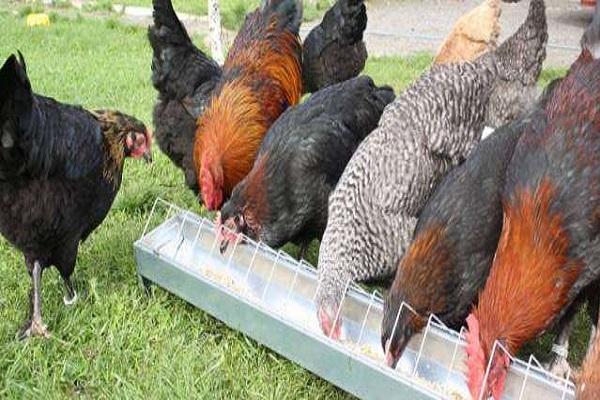
Breeding chickens
The rooster is enough for 10-15 females. Brahma chickens are excellent brood hens, and therefore this breed is quite easy to breed. Laying hens are characterized by a peaceful nature.For breeding, it is recommended to use females at least 3 years old. This allows you to get strong chicks.
Chicks hatched later than June develop poorly. By winter, they do not have time to get stronger, and therefore get sick more often. Youngsters 4-5 months are kept separately.
Possible difficulties
Chickens of this breed are characterized by slow growth. Chicks are quite demanding to care and feed. At the same time, the hatchability rate of chickens is almost 100%. The main characteristic of the incubation period is good warming up of the incubator. This is especially true in the first 5-6 days after laying the eggs.
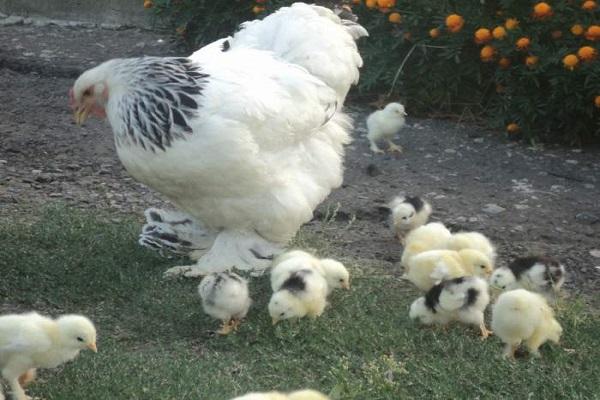
After hatching, chicks are strictly forbidden to take them outside. Chicks should be placed in a box covered with straw and placed under an artificial light. Only a week later, chicks are allowed to be released outside for several hours.
How to feed the chickens?
Usually poultry farmers use a special feed that includes crushed eggs, wheat grits and corn. Sometimes they give cottage cheese with herbs. Also, chicks need granulated feed. It has a beneficial effect on their development.
Common diseases and their prevention
In general, these chickens are considered unpretentious. However, sometimes they face disease. When raising birds, it is recommended to strictly follow the rules of hygiene. To avoid the appearance of parasites, ash or ash should be added to the bedding.
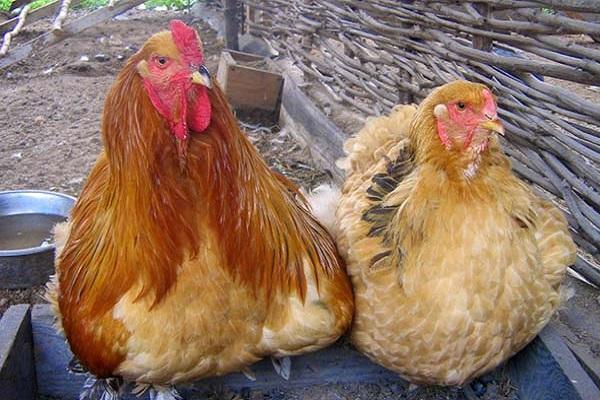
Young birds may be exposed to avian influenza. Timely vaccination will help to avoid this. Chicks should also be protected from drafts. To prevent rickets, fish oil is given to the chicks once a week.
Chickens Brama are characterized by excellent productivity and excellent decorative characteristics. To achieve good results in raising birds of this breed, it is recommended to provide the birds with quality care.
